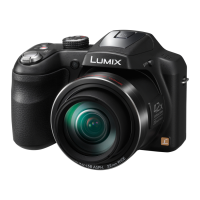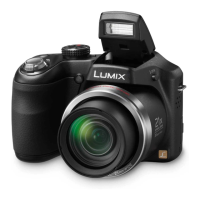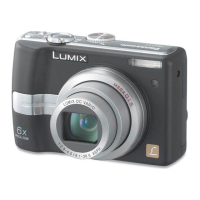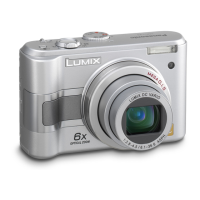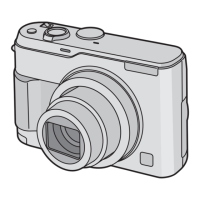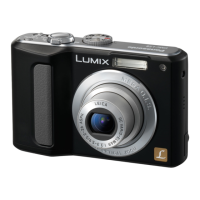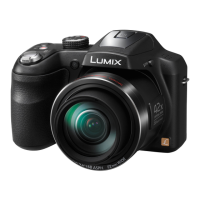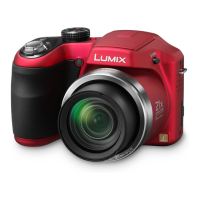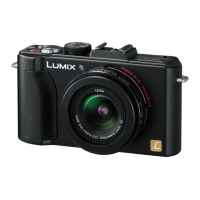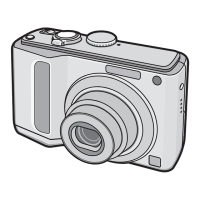
Do you have a question about the Panasonic DMC-LZ8 and is the answer not in the manual?
| Effective Pixels | 8.1 Megapixels |
|---|---|
| Optical Zoom | 5x |
| LCD Screen Size | 2.5 inches |
| Digital Zoom | 4x |
| Shutter Speed | 8 - 1/2000 sec |
| Image Sensor Size | 1/2.5 inch |
| Image Sensor | CCD |
| ISO Sensitivity | 100 / 200 / 400 / 800 / 1600 |
| Video Recording | 640 x 480 @ 30fps |
| Storage Media | SD/SDHC Memory Card |
| Battery Type | 2x AA batteries |
| ISO Sensitivity (High Sensitivity Mode) | 3200 |
| Image Stabilization | Mega OIS |
Instruction to read the manual completely before using the camera.
Important safety precautions to prevent fire, electric shock, or product damage.
Guidelines for proper disposal of electrical and electronic equipment.
Instructions on camera care and information regarding the LCD monitor.
Lens handling, condensation prevention, long-term storage, and compatible memory cards.
List of accessories included with the camera for initial use and setup.
Identification and description of all buttons, dials, and parts of the camera.
A brief overview of essential steps for inserting batteries, turning on, and taking/playing pictures.
Information on usable and unusable battery types, and their proper handling.
Guidelines for safe battery handling, prohibited shapes, and proper care.
Approximate number of recordable pictures and playback time for different battery types.
Recordable picture counts at 0°C, highlighting performance decrease in low temperatures.
Step-by-step instructions for inserting and removing batteries and memory cards.
Information on using the built-in memory and compatible memory cards (SD, SDHC).
Guide to setting the camera's clock and date for the first time.
Overview of recording and playback modes, and how to select them.
Explanation of the camera's menu system and how to change settings.
How to configure basic camera settings like battery type, clock, and display.
Details on settings like Battery Type, Clock Set, World Time, Monitor, LCD Mode, and Guide Line.
Settings for Histogram, Travel Date, Power Save, Auto LCD Off, and Auto Review.
Settings for file numbering, resets, USB mode, and video output.
Settings for units, scene menu, dial display, formatting, and language.
Displaying demonstrations of camera features like jitter and subject movement detection.
Details on the information displayed on the LCD monitor in different modes.
Guide to taking pictures easily using automatic settings in Intelligent Auto Mode.
Taking pictures with more control using Programme AE Mode.
Understanding exposure, focus, and colour issues for better shot results.
Using optical, extra optical, and digital zoom for closer or wider shots.
How to select and view pictures in normal playback mode.
Instructions for deleting single pictures or multiple pictures from memory.
Changing the information displayed on the LCD monitor in different modes.
Understanding and interpreting histograms for exposure analysis.
Adjusting LCD monitor settings (AUTO, POWER LCD, HIGH ANGLE) for improved visibility.
Guide to selecting and using the built-in flash for various shooting situations.
Available flash settings by mode and effective flash range details.
Instructions for taking close-up photos and using the self-timer.
Adjusting exposure compensation to manage brightness differences.
Taking multiple shots with varying exposures automatically.
Manually setting aperture, shutter speed, and exposure for creative control.
Using Advanced Scene Modes for optimized shots of people, scenery, and sports.
Using Scene Mode to match camera settings to specific shooting situations.
Details on Food, Party, Candle light, and Self portrait modes.
Details on Sunset, Baby, Pet, High sensitivity, and Beach modes.
Details on Starry sky, Fireworks, Snow, and Aerial photo modes.
Shooting rapid movement with high-speed burst and recording motion pictures.
Adjusting motion picture aspect ratio and quality settings.
Recording vacation dates by setting departure and return dates.
Displaying home and travel destination times simultaneously.
Accessing and using the REC mode menu to adjust picture settings.
Setting picture size (pixels) and quality (compression) for printing and storage.
Changing aspect ratio and using Intelligent ISO for exposure.
Setting ISO sensitivity manually and adjusting white balance for natural colors.
Manually setting white balance using a white reference for accurate colors.
Selecting metering modes (Multiple, Centre-weighted, Spot) for exposure measurement.
Setting focus modes (Face detection, 9-area, 3-area, 1-area) and Quick AF.
Explanation of high-speed focusing modes and Quick AF functionality.
Shooting in burst mode and applying color effects to pictures.
Adjusting picture quality and using the stabilizer feature for camera shake.
Setting minimum shutter speed and using the AF assist lamp for focus.
Viewing multiple pictures simultaneously on the LCD screen.
Searching and displaying pictures based on their recording date using a calendar.
Enlarging pictures during playback to view details.
Automatically playing back pictures in sequence as a slide show.
Applying visual effects and configuring duration, repeat options, and music for slide shows.
Classifying and playing back pictures based on recording information like scene mode.
Playing back only the pictures that have been marked as favorites.
Playing back recorded motion pictures, including controls and limitations.
Overview of functions available in the playback mode menu.
Searching pictures by recording date using the calendar function.
Adding text comments to pictures.
Stamping set text, date, age, or travel date onto pictures.
Reducing picture file size for easier email attachment or web upload.
Trimming unnecessary parts of a recorded picture.
Converting 16:9 aspect ratio pictures to 3:2 or 4:3.
Rotating pictures manually or automatically displaying them vertically.
Setting and managing favorite pictures for playback and slide shows.
Setting pictures and print quantities for DPOF compatible printing.
Preventing accidental erasure of pictures by setting protection.
Copying picture data between the built-in memory and a card.
Connecting the camera to a PC for transferring pictures and using software.
PC connection modes, folder structure, and motion picture playback on PC.
Important precautions and steps for connecting and transferring data via USB.
Connecting the camera directly to a PictBridge printer for direct printing.
Printing single or multiple selected pictures directly from the camera.
Configuring print settings like date, copies, paper size, and layout.
Troubleshooting and precautions for direct printing via PictBridge.
Connecting the camera to a TV using AV cable for playback.
Information on connecting and using the AC adapter and DC coupler.
Explanation of icons and information displayed on the LCD monitor in recording mode.
Explanation of icons and information displayed on the LCD monitor in playback mode.
General precautions for safe use and instructions for camera maintenance.
Important notes on battery removal, card handling, data safety, and tripod use.
Explanation of common confirmation and error messages displayed on the camera.
Common issues with batteries, power, shooting, focus, and image quality with solutions.
Troubleshooting common LCD monitor and flash issues.
Troubleshooting playback issues and connectivity problems with TVs, computers, and printers.
Tables showing recordable pictures and recording times for various settings and cards.
Technical specifications of the camera, including power, sensor, lens, and focus.
Summaries of burst mode, ISO, shutter speed, white balance, exposure, metering, LCD, flash, and media.
Details on picture resolutions, file formats, interface, terminals, dimensions, and operating conditions.
